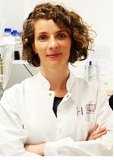Welcome to the 5 candidates teams.

Dr. Carsten HOFFMANN
Institute for Molecular Cell Biology
CMB—Center for Molecular Biomedicine
University Hospital Jena,
Friedrich Schiller University Jena
https://www.uniklinikum-jena.de/zellbiologie/en/
Germany
ORCID-ID: 0000-0003-0884-9300
Why do you want to join the IRN?
Today successful Science is done on a collaborative “give and take” basis. A membership with the IRN would enable us to further deepen our interaction with European research groups without the time limitations seen in ERNEST as a cost-action program. I personally have experienced lab exchanges as a PhD students (to France and Poland) and later as post-doc (USA) and would like to pass this fascinating experience on to young researcher to host stays in my institute or send my students to member labs as an exchange.
Short description of current research interest
Our institute of molecular biology at the university hospital Jena is investigating the interaction of GPCRs with arrestin and GRKs as key proteins in the regulation of GPCR signaling by phosphorylation with special application to signaling in cancer and aging processes. We are applying a range of approaches including the development of resonance energy transfer-based sensors, plate-reader assays (BRET and FRET) and microscopic imaging in combination with CRISPR/Cas9 gene edited cell lines which we produce ourselves to investigate receptors signaling and regulation with space and time resolution in living cells. Other members of the University Hospital Jena like Prof. Dr. Stefan Schulz as head of the Institute of pharmacology and toxicology and his group are studying receptor phosphorylation using phospho-site specific antibodies for GPCRs and in vivo models.

Dr. Nicolas WOLFF
Team Signaling and Molecular Interactions
Département Neuroscience, CNRS UMR 3571
Institut Pasteur,
25 rue Du Docteur Roux, 75015 Paris, France
France
https://research.pasteur.fr/fr/team/group-nicolas-wolff/
Why do you want to join the IRN?
Since many years, my team has a particular interest in studying the structure and dynamics of multi-domain proteins and their interactions. We have been developing our project around the GPCR ADGRV1 for a few years and obviously we do not have the experience of most of the other i-GPCRnet teams concerning this family of proteins. Joining this consortium would obviously be very helpful for us because we could share our experiences on the molecular and functional properties of this class of protein which, although very diverse, shares a certain number of common characteristics. I am also convinced that the very wide variety of GPCR is also a source of inspiration to study our own GPCR which is expressed in different cell types with no idea of its function for most cases, except in the cochlea or retina.
Short description of current research interest
Our main project aims at deciphering the molecular composition, structure, and functional regulation of the Usher2 complex that sustain the pathophysiological development and functioning of cochlear sensory hair cells. The human Usher2 syndrome is the most common genetic cause of combined deafness and blindness. Associated to the Usher2 disease, two transmembrane proteins, usherin and the adhesion G protein-coupled receptor ADGRV1, and the cytoplasmic proteins whirlin and PDZD7, form the Usher2 complex in the sensory hair cells of cochlea. These proteins form transient fibrous links between stereocilia at the surface of the hair cells. The long extracellular domain of ADGRV1 (6000 aa) builds the core of the link while its cytoplasmic domain connects to whirlin and PDZD7 that in turn associate to actin-binding protein. The GPCR ADGRV1 has two crucial functions in sensory cells; i) scaffolding and ii) signaling. During hair cell development, ADGRV1 undergoes autoproteolysis producing an active transmembrane subunit that can be specifically inhibited by PDZD7. The underlying molecular mechanisms being unknown, we are elucidating the composition, structure, regulation and downstream signaling of the ADGRV1 complex, wild-type but also sharing pathogenic Usher2 mutations, combining proteomics, NMR, SAXS, and Cryo-electron microscopy & tomography.

Dr. Livio CASARINI
Unit of Endocrinology,
Department of Biomedical,
Metabolic and Neural Sciences.
University of Modena and Reggio Emilia,
Modena
Italy
https://personale.unimore.it/rubrica/dettaglio/lcasarini
Why do you want to join the IRN?
I feel that IRN offers a unique occasion to join and share science with top-researchers in the field of GPCRs. I admire the quality of studies from IRN associated group since long time, and I am sure that the IRN network is a valuable platform where mid-career scientists may improve their advanced GPCR studies and grow up a new generation of talented young fellows. Most of my activities are already exerted within collaborations with other scientists active in the field of GPCRs, aiming to characterize how these receptors modulate reproductive and other endocrine functions. Therefore, my academic research and development of new products for medical purposes will surely benefit from the advanced knowledge exchanged through the IRN network.
Short description of current research interest
Research interests are focused on the mode of action of pituitary hormones and sex steroids through their GPCRs, within field of endocrinology of reproduction and metabolism. These studies aim to dissect the pathophysiological significance of receptor-receptor interactions, single nucleotide polymorphisms of GPCR and trafficking molecules, and action of hormone glycoforms. Current main projects are on the development of nano-antibody fragments, targeting ovarian GPCRs, and acting as allosteric modulators for contraceptive purposes, and on the comprehension of the neglected role of gonadotropin and sex steroid GPCR heteromers. The research is based on the use of high-throughput and advanced approaches such as BRET/FRET, HTRF, Alpha and proximity ligation assay, accompanied by classical methods for signalling studies from biochemistry and cell biology.

Dr. Shuguang YUAN
AlphaMol Science Ltd
Basel
Switzerland
http://www.alphamol.com
Why do you want to join the IRN?
IRN is a high-quality international consortium for GPCR, bridging basic research and industrial
application. Many top scientists are within this network. Our team is mainly focusing on GPCR molecular mechanism and innovative biotechnology development. IRN provides a very good platform for extensive collaborations across the GPCR community world-wide.
Short description of current research interest
The major focus of AlphaMol is GPCR small molecule drug discovery via computational methods in an ultimately efficient way. Specifically, we work on (1) the molecular mechanism study of GPCRs, (2) developing new computational tools and algorithm to facilitate GPCR drug discovery, (3) investigating pharmacological functions of orphan GPCRs, and (4) discovering new drug candidates for GPCRs that related to immunology and neurology.


Dr. Martyna Szpakowska Dr. Andy Chevigné
Luxembourg Institute of Health
Department of Infection and Immunity
L-4354 Esch-sur-Alzette
Luxembourg
Why do you want to join the IRN?
Our research group at the Luxembourg Institute of Health has a strong tradition of international collaborations and networking. We would like to join the IRN and associate Luxembourg with this excellent initiative and actively support it.
Short description of current research interest
The group of Immuno-Pharmacology and Interactomics (IPI) is part of the Department of Infection and Immunity (DII) of the Luxembourg Institute of Health (LIH) and is jointly led by Dr. Martyna Szpakowska and Dr. Andy Chevigné. The main interests of the group are G protein-coupled receptor biology and pharmacology with a strong focus on chemokine receptors and peptide-binding GPCRs.
